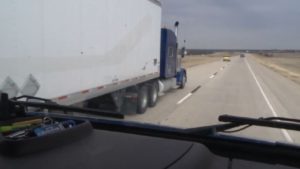BY: Neil Anderson, Esq.
Driving with Giants…Share the Road, take precautions:
Trucks and Passenger Vehicles
“Horrifying Moment, tractor trailer sparks deadly 28 vehicle crash”
“True Carnage” Semi Truck Driver Charged”
“Two Killed in Multiple Tractor Trailer Wreck”
“’It looked Horrible’ : 3 Injured in Fiery Tractor-Trailer Crash”
For better or worse, we all share the road with giants. Commercial trucks are the giants of the roadways. They are large, heavy; take up more space, and are far less maneuverable than other vehicles. While they serve many valuable and necessary purposes and are driven largely by experienced, professional drivers, their constraints and limitations create dangers to other vehicles. Drivers of passenger vehicles often do not take extra precautions when sharing the road with trucks. As the headlines from the past few months indicate, the results can be disastrous. Fortunately, there are many things you may do to make driving with trucks a much safer proposition. First, it is important to understand some of the factors that necessitate driving conscientiously, cautiously, and defensively.
Hazards of Driving Near Trucks
- Larger blind spots: Semi-trucks have blind spots that extend for long ranges on their sides as well as in the front and back. Truck drivers cannot see other vehicles in these blind spots, making it dangerous to drive in them.
- Longer stopping time and distance: Due to their size and weight, semi-trucks take longer to stop. If a sudden hazard arises, trucks may not be able to stop safely in time to avoid it.
- Slower to react: Due to their size, semi-trucks cannot react to traffic situations as quickly as passenger cars. Merging and making lane changes take longer in a truck than a passenger car.
- Wider turns: Trucks need more space to safely turn, especially when turning right. Underestimating this space can put passenger cars in the path of the turn, causing a collision.
- Impacted by wind: Large trailers can act almost like a sail, so when heavy winds blow they are harder to control. A truck’s trailer could be blown over, causing a collision.
Driving Safely Near Trucks
Avoid Blind Spots
Trucks drivers can not see what you see and have many blind spots that prevent them from seeing your vehicle. Blind spots on a truck are:
- 20 feet in front of the cab
- 30 feet from the rear of the trailer
- To the left, from the cab back to about the middle of the trailer, one lane wide
- To the right, from the cab at an angle to the area behind the trailer, extending two lanes wide
Allow Extra Space. Trucks not only take up a lot more space than a passenger vehicle, they need significantly more space to safely change lanes, make turns, or brake. Give yourself plenty of distance when you drive in front of or next to them. Trucks need up to 55 feet to make a turn. If you squeeze in this lane, the truck driver will likely not see you and your vehicle could be hit as the truck turns. Give the trucks plenty of space and pay attention to the signals they give. Also, if stopped at an intersection, stay behind the white line to allow trucks all of the space they need to make a turn. If you are passing a truck, do so on the truck’s left side whenever possible. It helps avoid blind spots. When you have passed the truck and are returning to your lane of travel, allow plenty of space by making sure you can see the truck in the rearview mirror before moving back in front of the truck. Conversely, when a truck is passing you, stay in the right lane and slow down. This allows the truck to pass quickly and safely and allows the truck driver to minimize his blind spot. Be aware that in passing a truck there is a variable to consider. That is the wind. The higher the profile of the vehicle, whether it’s a truck, RV, or some other type of vehicle, the more likely it becomes subject to strong winds. The bigger and higher the truck is, the more likely, when you’ve got crosswinds of 50 to 60 mph, that the truck can make a sudden movement into other lanes or even flip over. Also, keep Your Speed Consistent. Truck drivers cannot adjust to speed changes as quickly as passenger vehicle drivers can. Trucks take longer to slow down and longer to accelerate. When your speed fluctuates, the truck driver is not able to adjust as quickly. Maintaining a steady speed will help you avoid collisions caused when the truck driver cannot slow down quickly enough. If you are in an Accident, seek expert Medical and Legal Advice. If you or a loved one has been injured in an automobile or truck accident, in addition to seeking the medical attention you need, schedule a free consultation at the Tramontozzi Law Offices as soon a reasonable. John Tramontozzi and his associate Neil Anderson offer thorough and knowledgeable advocacy. John Tramontozzi is a former insurance defense counsel and has extensive experience, working on both sides of the issue, as well as years in private practice. This experience saves time, worry, and minimizes unnecessary expenses.
Additional Related blogs:
Tramontozzilaw.com/ten-things-to-do-if-you-are-in-a-car-accident-in-massachusetts/
What to do if I am Hit by a Car http://tramontozzilaw.com/what-to-do-if-i-am-hit-by-a-car/

